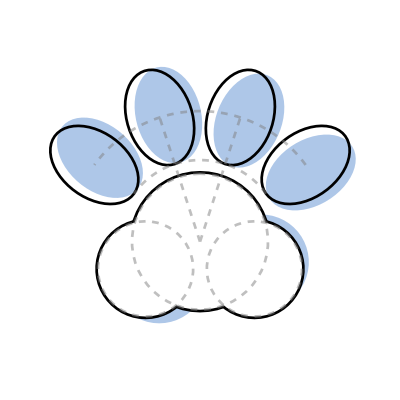Annotation
Diagramatics provide functions to annotate diagrams.
// by default, the text will be in the tip of the arrow,
// you can change the position of the text using `text_offset`
let sq = square(10);
let vann1 = annotation.vector(V2(0,-8), "mg", V2(1.5,0) , 0.4)
.stroke('blue').fill('blue');
let vann2 = annotation.vector(V2(3, 0), "F" , V2(-0.5,1.5), 0.4)
.stroke('blue').fill('blue')
.position(sq.get_anchor('center-right'));
draw(sq, vann1, vann2)
annotation.vector (
v
:
Vector2 , str?
:
string , text_offset?
:
Vector2 , arrow_head_size?
:
number )
:
Diagram
// by default, the text will be in the tip of the arrow,
// you can change the position of the text using `text_offset`
let sq = square(10);
let vann1 = annotation.vector(V2(0,-8), "mg", V2(1.5,0) , 0.4)
.stroke('blue').fill('blue');
let vann2 = annotation.vector(V2(3, 0), "F" , V2(-0.5,1.5), 0.4)
.stroke('blue').fill('blue')
.position(sq.get_anchor('center-right'));
draw(sq, vann1, vann2)
// annotate angle ∠ABC given the point [A,B,C]
// the default position of the text is at distance the point B
// you can change the position of the text using `text_offset`
let points = [V2(4,3), V2(3,0), V2(0,0)]
let tr = polygon(points);
let ann = annotation.angle(points, "\\theta", 0.4, 0.6)
.fill('lightblue').strokewidth(2).stroke('blue');
draw(tr, ann);
annotation.angle (
p
:
[Vector2, Vector2, Vector2] , str?
:
string , radius
:
number = 1 , text_offset?
:
Vector2 | number )
:
Diagram
// annotate angle ∠ABC given the point [A,B,C]
// the default position of the text is at distance the point B
// you can change the position of the text using `text_offset`
let points = [V2(4,3), V2(3,0), V2(0,0)]
let tr = polygon(points);
let ann = annotation.angle(points, "\\theta", 0.4, 0.6)
.fill('lightblue').strokewidth(2).stroke('blue');
draw(tr, ann);
// the order of points determine which angle to be annotated
// the angle will be in the counter-clockwise direction
// *if you want to annotate the smaller angle, use `annotation.angle_smaller`
let points = [V2(0,0), V2(3,0), V2(4,3)]
let tr = polygon(points);
let ann = annotation.angle(points, "\\theta", 0.4, -0.6)
.fill('lightblue').strokewidth(2).stroke('blue');
draw(tr, ann);
// the order of points determine which angle to be annotated
// the angle will be in the counter-clockwise direction
// *if you want to annotate the smaller angle, use `annotation.angle_smaller`
let points = [V2(0,0), V2(3,0), V2(4,3)]
let tr = polygon(points);
let ann = annotation.angle(points, "\\theta", 0.4, -0.6)
.fill('lightblue').strokewidth(2).stroke('blue');
draw(tr, ann);
let points = [V2(0,0), V2(3,0), V2(4,3)]
let tr = polygon(points);
let ann = annotation.angle_smaller(points, "\\theta", 0.4, 0.6)
.fill('lightblue').strokewidth(2).stroke('blue');
draw(tr, ann);
annotation.angle_smaller (
p
:
[Vector2, Vector2, Vector2] , str?
:
string , radius
:
number = 1 , text_offset?
:
Vector2 | number )
:
Diagram
let points = [V2(0,0), V2(3,0), V2(4,3)]
let tr = polygon(points);
let ann = annotation.angle_smaller(points, "\\theta", 0.4, 0.6)
.fill('lightblue').strokewidth(2).stroke('blue');
draw(tr, ann);
// if not defined, `text_offset` is `2*offset`
let points = [V2(0,0), V2(3,0), V2(4,3)];
let tr = polygon(points);
let ann = annotation.length(points[1], points[2], 'x', 0.3, 0.2).stroke('blue');
draw(tr, ann);
length (
p1
:
Vector2 , p2
:
Vector2 , str
:
string , offset
:
number ,
tablength?
:
number , textoffset?
:
number , tabsymmetric
:
boolean = true )
:
Diagram
// if not defined, `text_offset` is `2*offset`
let points = [V2(0,0), V2(3,0), V2(4,3)];
let tr = polygon(points);
let ann = annotation.length(points[1], points[2], 'x', 0.3, 0.2).stroke('blue');
draw(tr, ann);
